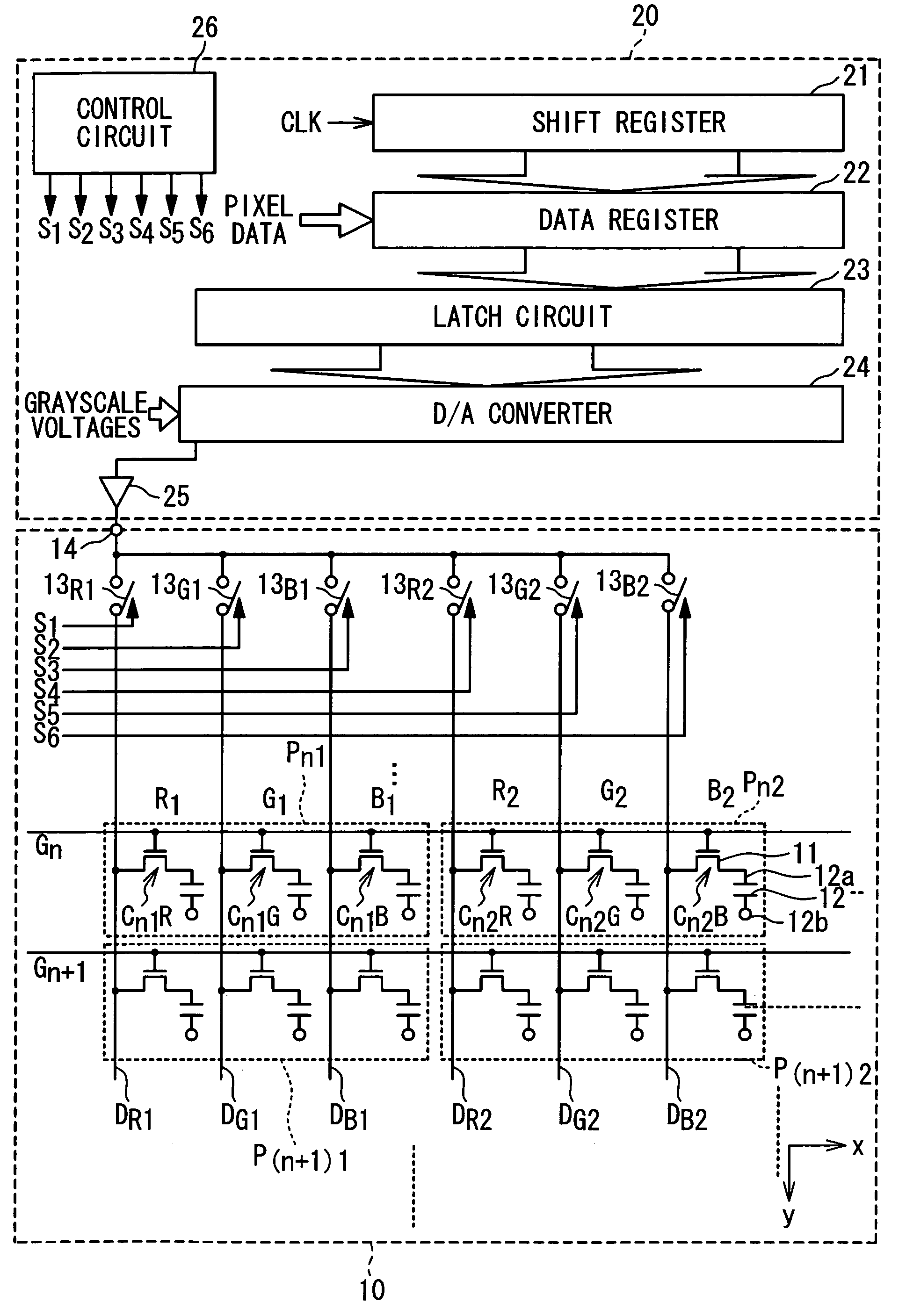Method and apparatus for display panel drive
- Summary
- Abstract
- Description
- Claims
- Application Information
AI Technical Summary
Benefits of technology
Problems solved by technology
Method used
Image
Examples
first embodiment
1. Structure of Display Device
[0060] In a first embodiment, as shown in FIG. 2, a display panel driving method according to the present invention is employed in a display device designed to drive six signal lines in a time-divisional manner. The display device according to the first embodiment is almost similar in the arrangement to the display device shown in FIG. 1, except that the number of signal lines to be driven by a single amplifier is different. Like components shown in FIG. 2 are denoted by like numerals as those shown in FIG. 1. The display device in the first embodiment will schematically be described.
[0061] In this embodiment, the display device is composed of a liquid crystal panel 10 incorporating an array of pixels, and a driver 20 for driving the liquid crystal panel 10. The liquid crystal panel 10 includes a set of scanning lines G1, G2 . . . , signal lines DR1 and DR2 associated with red, signal lines DG1 and DG2 associated with green, and signal lines DB1 and ...
second embodiment
1. General Outline
[0120] A display panel driving method of the second embodiment of the present invention is illustrated in FIGS. 6A to 6C, 7A to 7C, 9A to 9C, 11, and 12, where examples of the drive sequence of each line are shown. In the second embodiment, the display panel driving method is modified from that of the first embodiment for driving a display panel in which the number of the pixel sets for each input terminal is 2×K, K being an integer equal to or more than 2; in other word, the display panel driving method of this embodiment addresses driving 6×K signal lines with a single amplifier in a time divisional manner.
[0121] The drive sequence of each line in the second embodiment is also determined so as to satisfy the requirements described in the first embodiment. For example, the ordinal number of each pixel in a specific line is determined as being different from that of the corresponding pixel in the adjacent line. Additionally, the ordinal numbers of the G pixels a...
third embodiment
1. Structure of Display Device
[0192] A third embodiment of the present invention will be described in conjunction with a display device, shown in FIG. 13, where three signal lines are time-divisionally driven by the foregoing display panel driving method. In this embodiment, a liquid crystal display panel 10′ is differentiated from the display panel 10 shown in FIG. 2 by the fact that the pixels within the pixel set Pi1 are connected to a different input terminals 14 from that connected with the pixels within the pixel unit Pi2. It is hence assumed that the input terminal connected with the pixel unit Pi1 is denoted by 141, while the input terminal connected with the pixel unit Pi2 is denoted by 142. Also, an amplifier connected to the input terminal 141 is denoted by 251, while another amplifier connected to the input terminal 142 is denoted by 252. More particularly, the R pixel Ci1R, the G pixel Ci1G, and the B pixel Ci1B within the pixel set Pi1, are connected through three sw...
PUM
 Login to View More
Login to View More Abstract
Description
Claims
Application Information
 Login to View More
Login to View More - R&D
- Intellectual Property
- Life Sciences
- Materials
- Tech Scout
- Unparalleled Data Quality
- Higher Quality Content
- 60% Fewer Hallucinations
Browse by: Latest US Patents, China's latest patents, Technical Efficacy Thesaurus, Application Domain, Technology Topic, Popular Technical Reports.
© 2025 PatSnap. All rights reserved.Legal|Privacy policy|Modern Slavery Act Transparency Statement|Sitemap|About US| Contact US: help@patsnap.com



